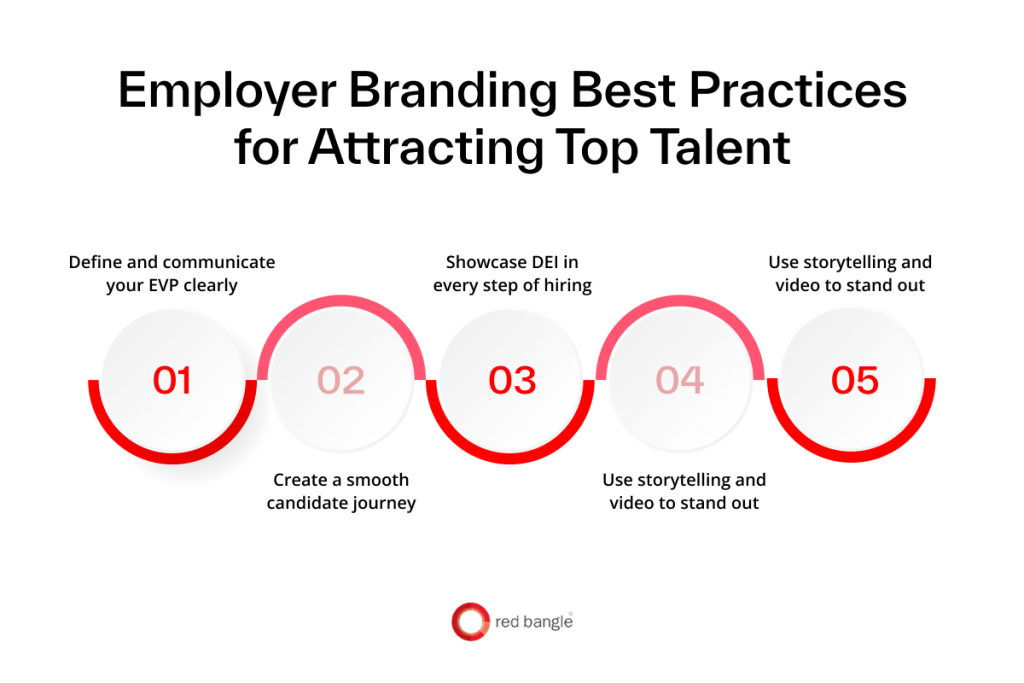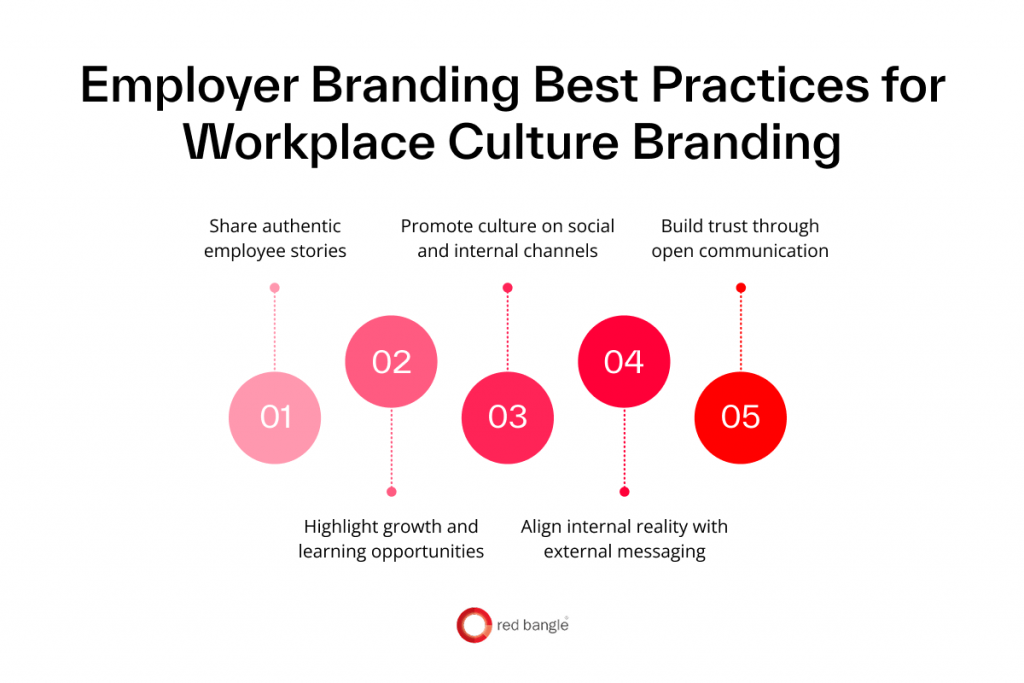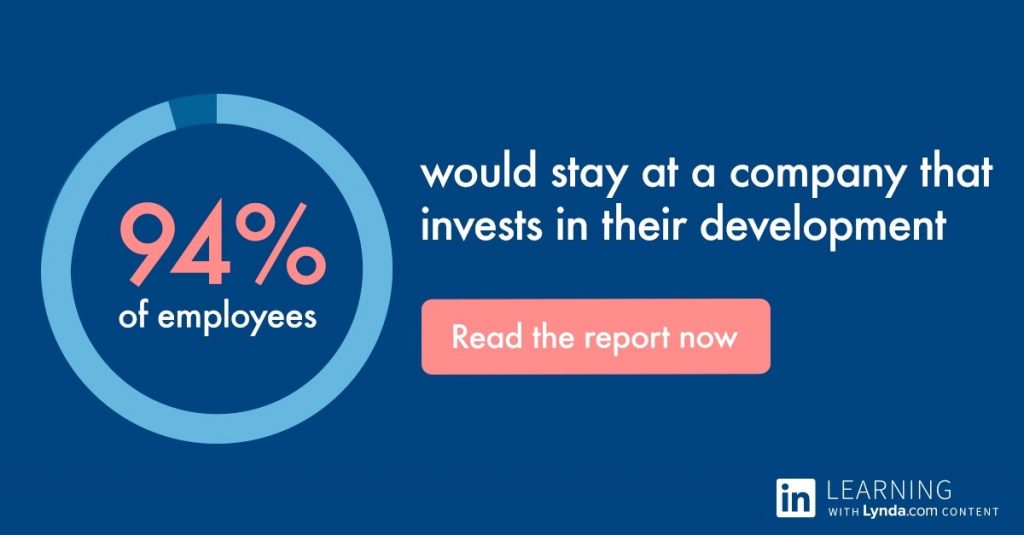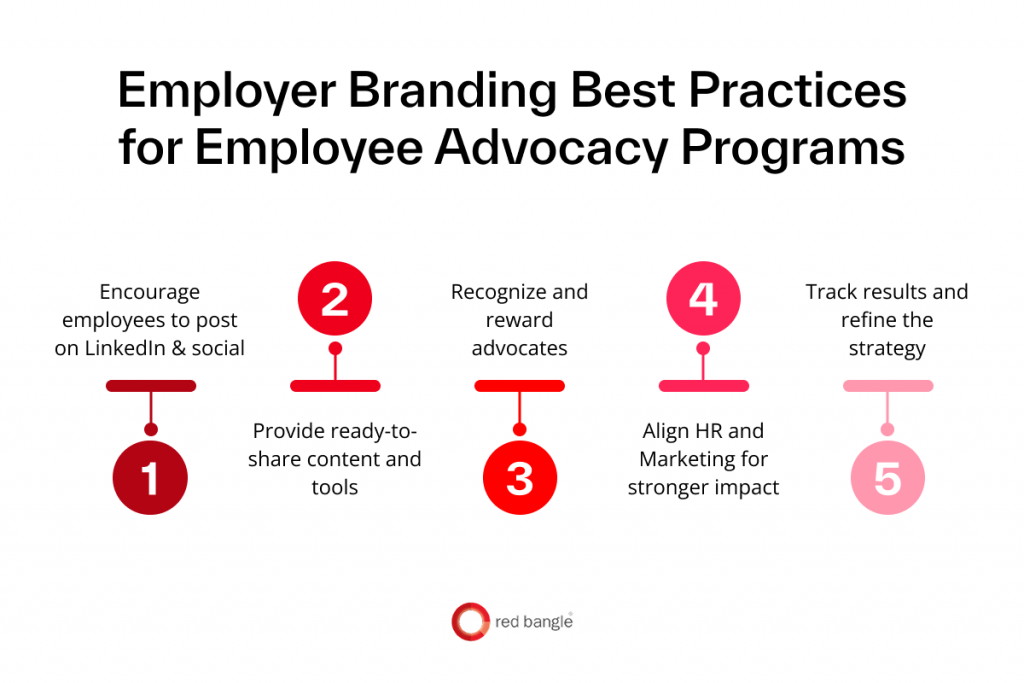Employer Branding Best Practices to Attract Top Talent
Turn your reputation into a recruiting edge. This guide breaks down 2025 employer branding best practices, from crafting a sharp EVP and human candidate journeys to activating employee advocacy and measuring ROI. So you attract aligned talent, cut hiring costs, and keep people engaged.

Introduction
Before people apply for jobs today, they investigate them, almost like planning a dream vacation. They check your company’s Glassdoor reviews, scroll through your Instagram feed, scan employee posts on LinkedIn, and look for signs that your values align with theirs.
They want to know: What’s it really like to work there? Will I belong? Can I grow? And if the vibe’s off? They swipe left, often before you even know they were interested.
That’s why employer branding has become more than a marketing initiative; it’s your first impression, your reputation, and the make-or-break moment when great talent decides to engage or move on.
75% of active job seekers are more likely to apply to a company that actively manages its employer brand, and organizations with strong employer brands see up to a 50% drop in cost per hire.
Forget the glossy videos and mission statements, employer branding runs deeper than that. Done right, it’s the sum of what you show, say, and live out, across every channel, every touchpoint, and every conversation.
What does that look like in practice? Three essential pillars:
- Attracting talent with a compelling presence and promise that feels real, not rehearsed.
- Culture branding that reflects what it’s actually like to work on your team, the highs, the quirks, the everyday moments that matter.
- Employee advocacy that turns your people into your most powerful storytellers and trust-builders.
In this guide, we’ll walk through employer branding best practices in 2025 that help you cut through the noise, build credibility, and connect with the people who’ll drive your company forward.
Let’s dive in.
What Is Employer Branding and Why Does It Matter?
Employer branding is how your company is perceived as a place to work. It reflects everything from your culture and values to your leadership style, employee experience, and the way you communicate with candidates.
In simple terms, it’s your reputation in the talent market, and in 2025, that reputation can make or break your ability to hire and retain the right people.
With job seekers doing more research than ever, your employer brand starts working long before a recruiter reaches out. Candidates are checking your Glassdoor reviews, social media presence, career site, and how your employees talk about you online. Employers who boosted their overall Glassdoor rating by at least 0.5 points saw 20% more job clicks and 16% more apply starts on average.
A big part of employer branding is your Employee Value Proposition (EVP). This is the clear, consistent message you send about what employees can expect from your company, whether it’s career growth, flexibility, meaningful work, or an inclusive culture. A strong EVP helps set expectations, attract the right candidates, and improve retention by reinforcing what makes your workplace unique.
Beyond hiring, employer branding benefits go far beyond recruitment. It boosts engagement, improves retention, and turns your employees into authentic advocates for your brand. When your internal culture matches the external image you promote, people stay longer, contribute more, and advocate for your company organically.
Strong employer branding isn’t optional anymore. It’s essential for attracting top talent, improving employee engagement, and building a workforce that fuels sustainable growth.
Employer Branding Best Practices for Attracting Top Talent

Attracting high-quality candidates requires a brand that goes beyond words, one that is consistently reflected in every candidate experience.
Here are five essential employer branding best practices in HRM to get it right:
1. Define and Communicate a Strong Employee Value Proposition (EVP)
Your EVP is the foundation of your employer brand. It’s your promise to current and future employees, what they’ll gain by working with you beyond just a paycheck. A compelling EVP includes aspects like career growth, flexible work options, purpose-driven culture, and leadership values.
According to Gartner, companies with a strong EVP see a 69% reduction in turnover and are 50% more likely to reach passive candidates in competitive talent markets. Yet only 21% of employees feel their organization clearly communicates its EVP. That’s a missed opportunity.
To fix this, define your EVP with input from real employees and ensure it’s visible across all hiring channels, career pages, job listings, LinkedIn, and interview conversations.
2. Optimize Candidate Experience from Application to Onboarding
The hiring journey is a major touchpoint for employer branding. From the first click on your job ad to the onboarding welcome email, candidates form strong opinions fast. That experience needs to be smooth, respectful, and aligned with your brand promise.
Glassdoor reports that 83% of job seekers consider employer reviews before applying, and a positive experience increases offer acceptance and referrals. Slow communication, unclear timelines, or a confusing application process can drive great candidates away, sometimes permanently.
Automation tools can streamline processes, but the human touch still matters. Ensure candidates receive timely updates, feedback, and clarity at every step. Onboarding should feel like an extension of the brand promise they saw during hiring.
This is one of the most impactful employer branding best practices examples, as it shows candidates you respect their time and experience.
3. Showcase Diversity, Equity & Inclusion (DEI) in Hiring
Candidates today want to work in inclusive environments. DEI is no longer a checkbox; it’s a differentiator. But it’s not enough to have a page on your site. DEI must be visible in the stories you share, the language you use, and the leaders you highlight.
Job seekers want to see real action: diverse representation in leadership, inclusive policies, and transparency about goals and progress.
Make DEI visible in your hiring campaigns, leadership stories, and visuals. It not only builds trust but also strengthens your employer branding benefits by attracting a wider and more engaged talent pool.
4. Use Storytelling and Video in Recruitment Marketing
Recruitment content needs to go beyond text. Storytelling, especially through video, can powerfully convey your culture, values, and what day-to-day life looks like inside your company.
Glassdoor data shows that employers who improve their rating by just 0.5 stars see a 20% increase in job clicks and 16% more applicants. That visibility often comes from honest, authentic content, something video excels at delivering.
A great example of this is Infosys’ EB Leadership Series, where Red Bangle crafted a set of storytelling videos featuring global leaders. Instead of generic brand lines, the films brought out real perspectives from leaders about culture, growth, and values. This not only humanized the leadership team but also helped candidates visualize themselves working alongside inspiring mentors.
Use short videos to highlight employee journeys, team culture, behind-the-scenes moments, and leadership perspectives. These stories not only build trust, but they also help candidates picture themselves as part of your company.
5. Keep Messaging Consistent Across All Channels
Consistency builds credibility. If your job ads say one thing, but your Glassdoor reviews or employee videos tell another story, candidates notice, and they hesitate.
To avoid this, ensure your EVP, tone of voice, and brand values are aligned everywhere, on career pages, LinkedIn, interview scripts, job boards, and internal communication. A unified brand voice reassures candidates and reinforces trust.
When these employer branding best practices work together, your employer brand does more than just attract applicants; it attracts the right ones. Candidates feel aligned before they even apply. New hires come in with clarity. And employees become brand advocates, not just workers.
Employer Branding Best Practices for Workplace Culture Branding

A strong culture isn’t about perks, it’s about people, growth, and shared purpose.
Real stories, transparent communication, and meaningful recognition help you improve employer branding from the inside out.
Examples of employer branding best practices in HRM include showcasing employee success stories, sharing learning programs, and building a community-driven work environment.
1. Build Authenticity Through Employee Stories
Nothing communicates culture better than real employee voices. Stories bring your values to life, help candidates imagine themselves in the role, and create trust.
Authentic storytelling, especially when shared by employees themselves, boosts credibility.
According to Edelman’s Trust Barometer, employees are 3x more trusted than CEOs when talking about working conditions. Encourage people to share their own perspectives, whether through blog posts, videos, or takeovers on LinkedIn and Instagram.
One strong way to build authenticity is by spotlighting real employees instead of polished brand ambassadors. Red Bangle’s ‘Know Your Recruiter’ series with Infosys did exactly this, putting recruiters front and center to share who they are as people.
It created trust with candidates while showing the company’s approachable side. This isn’t about perfect scripts; it’s about showing real people doing real work in a culture that values them.
2. Highlight Growth, Learning & Career Development Programs
Top candidates aren’t just looking for a job; they’re looking for growth. Your employer brand should reflect clear opportunities for learning, upskilling, and career progression.
According to LinkedIn’s Workplace Learning Report, 94% of employees say they would stay at a company longer if it invested in their learning and development.

Talk about your mentorship programs, internal mobility paths, manager-led development, and any certifications or coaching support available.
Make growth part of your brand story, not just your benefits page.
3. Promote Workplace Culture with Social Media & Internal Campaigns
Culture needs visibility. Leverage social platforms to share team wins, behind-the-scenes snapshots, culture rituals, and employee spotlights. Internally, run engagement campaigns that reinforce values, think recognition walls, culture awards, or #LifeAt[CompanyName] initiatives.
LinkedIn’s research shows that companies with a strong employer brand see 50% more qualified applicants and have lower cost-per-hire. Social visibility and internal culture campaigns play a big role in that.
Internal culture moments, when shared externally, make a huge impact. Take the Infosys Women’s Day campaign executed by Red Bangle; it wasn’t just a celebration, but a cultural story that amplified inclusivity and pride across employees and social channels.
What’s important is consistency; make your culture content feel human, relatable, and aligned with your EVP.
4. Align Internal Culture with External Employer Brand Messaging
Your internal experience should match what candidates see on the outside. If your brand promises flexibility, inclusion, or innovation, but your internal culture doesn’t deliver, employees will feel the disconnect, and they’ll talk about it.
Gartner reports that only 33% of employees believe their company delivers on its EVP promises. This misalignment hurts engagement and can damage your employer’s reputation over time.
The solution? Regularly audit your brand messaging against employee feedback. Use engagement surveys, focus groups, and Glassdoor insights to identify and close perception gaps.
5. Foster Employee Engagement & Retention Through Transparent Communication
Trust is the foundation of any great culture. That means being open with your people about goals, wins, challenges, and change. Transparent communication builds psychological safety and loyalty.
Make transparency part of your leadership style, not just your internal comms strategy. Use channels like town halls, Q&As, and manager-led team check-ins to ensure people feel heard and informed. When employees feel included in the bigger picture, they’re more likely to stay and advocate for your brand.
Your internal culture is one of your most powerful branding tools, because it’s impossible to fake and hard to replicate. When you align what happens inside with what you promise outside, you don’t just attract talent, you build loyalty, advocacy, and long-term impact.
Employer Branding Best Practices for Employee Advocacy Programs

Your employees are your most powerful brand ambassadors. When they share their experiences, stories, and cultural moments online, it adds credibility that no paid ad can match. In fact, content shared by employees gets significantly more reach and engagement than content shared by brands.
The key is to empower, support, and align employee advocacy with your broader employer branding goals. Here are five employer branding best practices to help you do that effectively.
1. Encourage Employee Advocacy on LinkedIn and Social Media
Employee advocacy starts with culture. When employees are proud of where they work, they naturally talk about it. Encourage them to share authentic moments, project wins, learning milestones, community involvement, or even casual behind-the-scenes snapshots.
Start with small nudges: employee spotlight campaigns, branded hashtags (like #LifeAt[YourCompany]), or asking employees to celebrate milestones on social platforms.
Example: CoLearn’s Approach to Recruitment Storytelling
In Indonesia, CoLearn found that talented STEM graduates were avoiding teaching careers, not because of a lack of skill, but because of perception: long hours, modest pay, aging infrastructure, and not being seen as a prestigious path.
Red Bangle helped CoLearn shift that narrative by producing testimonial videos featuring real, young STEM teachers. These videos highlight what a career with CoLearn actually looks and feels like: vibrant classroom scenes, meaningful connections with students, opportunities to grow, and stories that emphasize personal fulfillment.
The films were shot across two countries, using cinematic editing, strong b-roll footage, and authentic conversations to make teaching not just viable, but inspiring.
2. Equip Employees With Shareable Content & Tools
Many employees want to advocate for your company, but they just don’t know what to share or how to do it effectively. Make it easy.
Create a central content hub with ready-to-use visuals, branded templates, and messaging snippets for new job openings, culture moments, or industry insights. Include suggested hashtags, image guidelines, and sample captions to reduce friction.
Equipping your people with the right tools ensures brand consistency, boosts confidence, and increases overall participation in advocacy programs.
3. Recognize and Reward Advocacy Efforts
Advocacy thrives on recognition. Celebrate employees who actively represent your brand on social media or speak at events, write blogs, or refer top candidates.
This doesn’t have to be financial; recognition in town halls, internal shoutouts, or even a leaderboard on your intranet can go a long way. You can also gamify advocacy with small perks or incentives.
4. Collaborate Between HR & Marketing Teams for Stronger Employer Brand
Employee advocacy lives at the intersection of HR and marketing. HR brings insights into culture, values, and employee experience. Marketing knows how to scale messaging and measure performance.
When these teams work together, you get a cohesive, authentic narrative, one that resonates internally and externally. Align your EVP, recruitment goals, and brand voice to ensure advocacy efforts support both employer brand and talent acquisition strategies.
Hold regular cross-functional syncs, involve employees from both departments in advocacy planning, and ensure goals and KPIs are shared.
5. Measure the Impact of Employee Advocacy on Talent Attraction
To scale what works, you need to measure it. Track metrics like:
- Engagement rates on employee-shared posts
- Referral traffic to your careers page
- Number of employee advocates involved
- Quality of hire and referral source performance
Use tools like LinkedIn Campaign Manager, UTM tracking, or advocacy platforms to connect social impact with talent metrics.
Your people are already telling your story. The question is, are they telling the story you want to be known for?
By enabling, celebrating, and aligning employee advocacy, you build a more human, more trusted employer brand, one that scales beyond your careers page and deep into the networks that matter.
Measuring Employer Branding Success
Companies that track their employer brand performance consistently see stronger hiring outcomes, better retention, and higher employee engagement. Tracking performance is essential if you want to know how to improve employer branding over time.
Here are three ways to measure and improve employer branding success.
1. Key Metrics: Candidate Experience, Retention Rates, EVP Alignment
The first step is to track the outcomes that matter most. Look at how candidates feel during the hiring process, whether they’re satisfied with communication, and if they would recommend your company to others.
Retention rates are another crucial signal; when people stay longer, it’s often because the employer brand and the reality of working at your company match up.
Finally, check whether your employee value proposition (EVP) is clear and aligned with what employees actually experience. If the promise and the reality don’t match, your brand won’t hold up.
2. Employee Feedback and Engagement Surveys
Numbers tell you what’s happening, but employee feedback tells you why. Regular surveys, focus groups, and anonymous feedback channels help you understand how employees truly feel about your workplace.
These insights uncover whether people feel connected to the culture, trust leadership, and take pride in being part of the company. Listening to employee voices ensures you’re building a brand that reflects reality, not just marketing.
3. Adjusting and Iterating Branding Strategy Over Time
Employer branding is never “finished.” Your company evolves, the market shifts, and employee expectations change. That’s why you need to revisit your strategy often.
If candidates are dropping off during the hiring process, look at where communication can improve. If retention is slipping, reassess whether your EVP is still relevant.
When engagement is low, double down on culture and transparency. The best employer brands adapt as their workforce and business grow.
By tracking key metrics, listening to employees, and refining over time, you’ll not only protect your employer brand but you’ll also strengthen it as a long-term driver of growth, retention, and engagement.
Common Employer Branding Challenges and How to Overcome Them
Even the strongest employer brands face challenges. The key is recognizing them early and having strategies in place to overcome them. Here are three of the most common obstacles companies face and how to address them.
1. Attracting Niche Talent
Specialized roles often require more than a standard job posting. Niche talent wants to see purpose, innovation, and opportunities that align with their expertise.
To attract them, highlight projects, technologies, or initiatives that are unique to your business. Partner with industry communities, create thought leadership content, and showcase your experts online.
The more specific and authentic your messaging, the more likely you’ll resonate with highly skilled candidates.
2. Balancing Authenticity with Brand Polish
Candidates want to see the real story, not a glossy ad that feels too good to be true. The challenge for most companies is finding the sweet spot, sharing authentic employee voices while still presenting a professional, credible brand image. Lean too far into polish, and you risk losing trust; go too raw, and the message may not reflect your company’s values.
A strong approach is to let employees and culture speak for themselves, but frame it with just enough creative direction to make the story clear and engaging. Authenticity builds trust, while polish ensures consistency.
Red Bangle’s AI-powered Singalong and Face Swap campaign is a great example of this balance. By blending playful, tech-driven creativity with relatable, human storytelling, the campaign delivered something fresh that felt both authentic and professionally executed.
It showed how brands can experiment with new formats without losing sight of the people at the heart of the story, a balance that makes employer branding content memorable and shareable.
3. Keeping EVP Relevant as the Company Grows
An Employee Value Proposition (EVP) isn’t static. As companies expand into new markets or shift priorities, the EVP needs to evolve. What resonated with employees at a startup stage may not work in a global company.
Regularly revisit your EVP by listening to employees across levels and regions. Update messaging to reflect new opportunities, challenges, and benefits. A living EVP keeps your brand relevant and ensures promises match the current reality of work at your company.
The truth is, every company will face bumps when building an employer brand. What sets successful ones apart is how consistently they listen, adapt, and stay aligned with both employee expectations and business goals.
By addressing challenges head-on, you strengthen trust and ensure your brand continues to attract and retain the right people.
Conclusion
At the end of the day, great employer branding is about more than jobs; it’s about stories. The story of your culture, your people, and why someone would be proud to call your company home.
A clear EVP, a strong culture, and employee advocacy all play a part. But what really makes your brand stand out is how you bring those elements to life, authentically, consistently, and creatively.
Authentic videos, creative campaigns, and employee-driven stories do what job descriptions never can: they make people see themselves as part of your journey.
By following employer branding best practices in 2025, learning from proven employer branding best practices examples, and continuously refining how to improve employer branding, your organization can build a brand that attracts, engages, and retains the people who’ll shape your future.
At Red Bangle, we help brands transform their culture into compelling stories through films, videos, and creative media. Stories that inspire pride internally and attract the right talent externally.
If you want to build an employer brand that people connect with, not just read about, let’s tell that story together. Contact us today.



